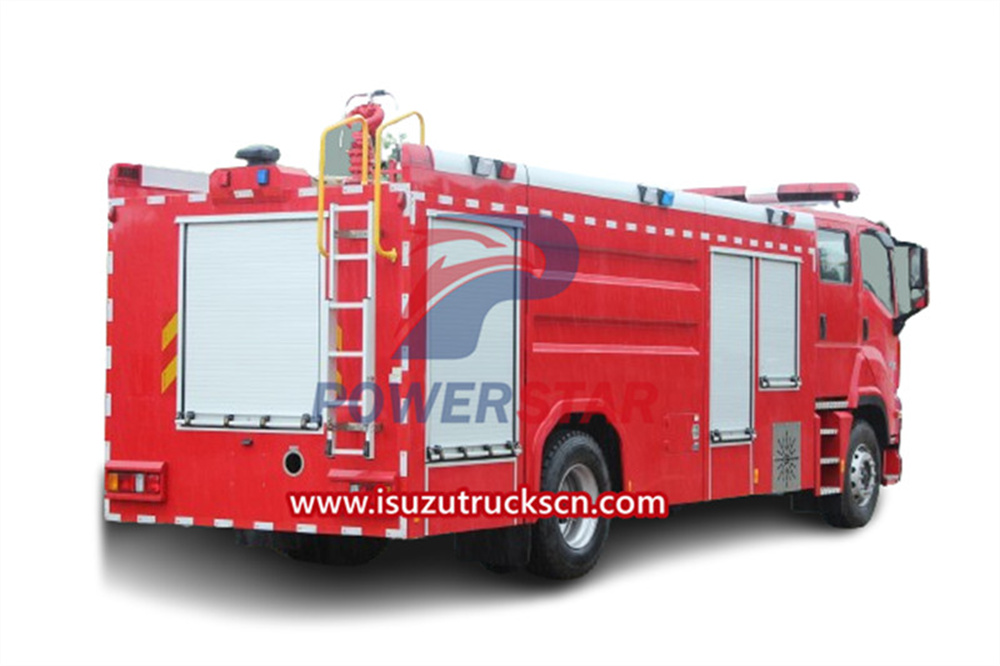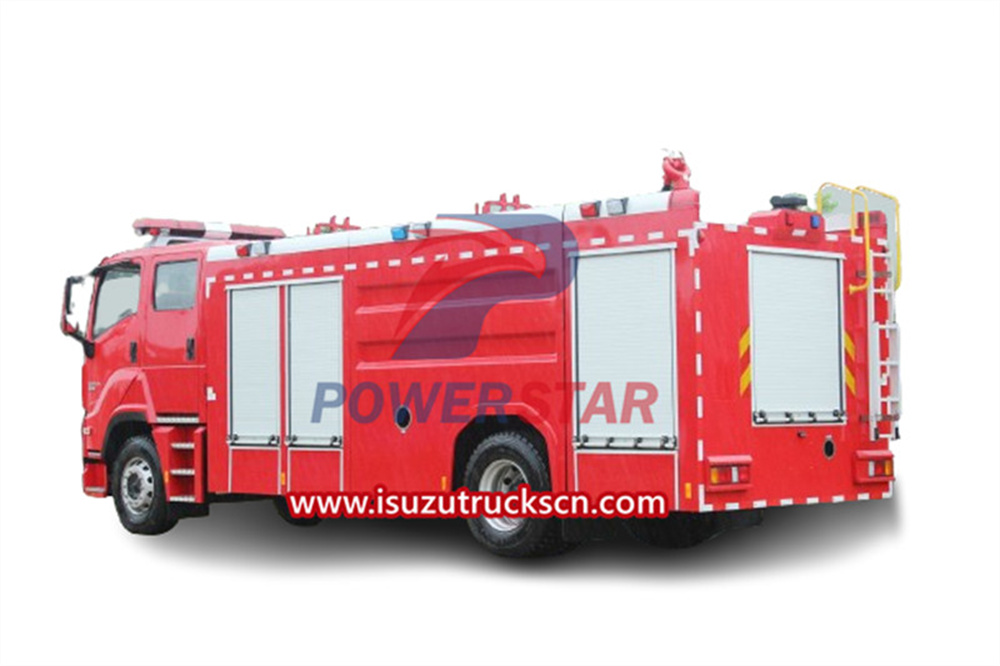


Common malfunctions and solutions for Fire Pump of the Isuzu Fire Truck
Fire pump refers to a special pump installed on fire trucks, fixed fire extinguishing systems or other fire fighting facilities and used to transport liquid fire extinguishing agents such as water or foam solution. It is well known that the core component of the Isuzu fire truck is the fire pump. However, once the fire pump fails, it will not be able to provide the fire truck with the water pressure and water volume required to extinguish the fire, and it will not be possible to carry out fire extinguishing and rescue operations at the best time. It will cause some unnecessary losses, so when the fire pump fails, it must be solved in time. So what are the common failures of fire pumps? How should we deal with these failures?
The main working principle of Isuzu fire truck fire pump
Fire pumps for fire trucks mainly use centrifugal water pumps. The working principle is that before starting the centrifugal pump, the pump casing and water suction pipe should be filled with the liquid to be transported. When the prime mover drives the pump shaft to rotate, it drives the impeller and water to rotate at high speed. At this time, the water is accelerated by centrifugal force and thrown out of the impeller. It flows into the discharge pipe of the water pump through the flow channel in the scroll pump casing. During this process, part of the kinetic energy of the water is converted into pressure energy. At the same time, a low-pressure area is formed at the center of the water pump impeller because water is thrown out. Under the action of the difference between the liquid surface pressure and the pressure inside the pump, the liquid enters the impeller of the pump through the suction pipe to fill the position of the discharged liquid. As long as the impeller keeps rotating, liquid is continuously sucked in and discharged.
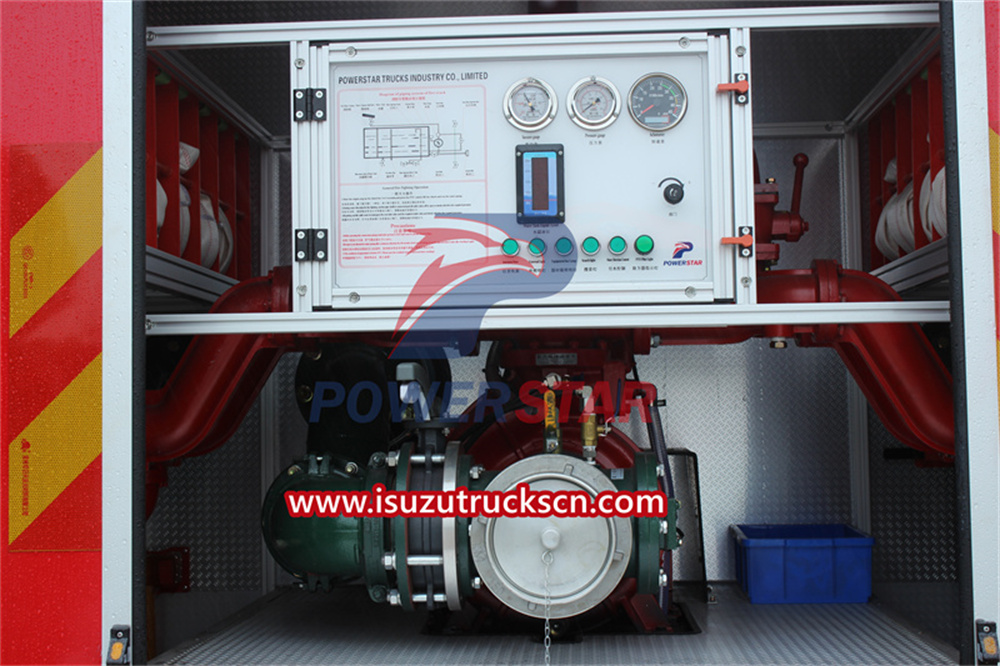
➹ Malfunction problem: What should I do if the fire pump cannot be started?
________________________________________
Approach:
1. First check the power supply:
Whether the joint connection is secure;
Whether the switch contact is tight;
Whether the fuse is blown;
Whether the three-phase power supply is equal or not.
If there is an open circuit, poor contact, blown fuse, or phase loss, the cause should be identified and repaired in time.
2. Secondly, check whether it is a mechanical failure of the water pump itself. Common reasons are:
The packing is too tight or the space between the impeller and the pump body is stuck and blocked by debris;
The pump shaft, bearings and leakage reducing ring are rusted;
The pump shaft is severely bent, etc.
Method of exclusion:
Loosen the filler and clear the water diversion channel;
Disassemble the pump body to remove debris and rust;
Remove the pump shaft and correct it or replace it with a new one.
➹Malfunction problem: The fire pump vibrates seriously
________________________________________
Approach:
1. The fire pump and the motor shaft are not concentric? [The effective energy obtained by the liquid passing through the fire pump is obtained from the impeller of the pump, and the energy obtained by the impeller is obtained from the pump shaft, and the energy obtained by the pump shaft is provided by the motor. . When the pump is running, the pump shaft drives the impeller to rotate at high speed. If the pump body and pump shaft are not installed correctly, the impeller will deviate and rub against the pump casing, causing vibration. In severe cases, the impeller and pump casing may be damaged. 】Adjust and align the fire pump and motor axis.
2. Is the fire pump shaft bent? Remove and straighten it or replace it with a new one.
3. The impeller is unbalanced? Remove it and find balance.
4. Are the parts of the rotating part loose or broken? Is the pipe support weak? [After the centrifugal fire pump is started, the impeller will rotate at high speed. If the installation of the centrifugal fire pump is not firm, or the fasteners become loose due to long-term operation, the pump will produce vibration and noise during operation, and may even be damaged in a short period of time. 】Reinforcement, straightening, replacement and other methods
5. Wear between the impeller and sealing ring [If the impeller and sealing ring cannot ensure good lubrication, wear will occur between the two and the gap will increase. When the gap exceeds a certain value, it will cause vibration and noise in the pump. The degree of wear increases with the running time of the pump. 】
6. Cavitation causes abnormal sound inside the pump
Excessive resistance in the suction pipeline, leakage of air due to loose sealing, excessive temperature of the liquid being sucked, excessive flow rate, etc. will cause cavitation, resulting in abnormal sounds or violent vibrations in the pump.
➹ Malfunction problem: The fire pump cannot pump out liquid
________________________________________
Approach:
1. The pressure-out pipe is too thin and the pipe loss is too great? Replace the pressure-out pipe with a suitable one.
2. The operating lift exceeds the design lift? Select a new fire pump.
3. There is air in the pump body or air accumulation in the water inlet pipe, or the bottom valve is not closed tightly and the water diversion is not full, the vacuum pump packing is seriously leaking, and the gate valve or flap door is not closed tightly. Troubleshooting method: Press the water up first, then fill the pump body with water, and then turn it on. At the same time, check whether the check valve is tight and whether there is air leakage in the pipelines and joints. If air leakage is found, apply lubricating oil or mixed paint to the joints after disassembly and tighten the screws. Check the oil seal ring of the water pump shaft. If it is severely worn, replace it with a new one. The pipes are leaking water or air. Maybe the nut was not tightened tightly during installation. If the leakage is not serious, you can apply cement or cement slurry mixed with asphalt oil on the air or water leakage area. Temporary repairs can be done with wet mud or soft soap. If there is water leakage at the joint, you can use a wrench to tighten the nut. If the water leakage is serious, you must reassemble and replace the cracked pipe; reduce the lift and press the nozzle of the water pump 0.5m underwater.
4. The suction height exceeds the allowable range? Reinstall the fire pump according to the allowable suction height.
5. To transport hot and volatile media? Reduce the suction lift or use reverse filling and installation.
6. The steering is reversed? Correct the steering.
7. No filling liquid? Refill the fire pump.
8. Is the flow path of the suction pipe, outlet pipe or fire pump blocked? Remove debris.
➹Malfunction problem: seal leakage
________________________________________
There are two types of fire pump seals: mechanical seals and packing seals. The mechanical seal has good sealing effect and long service life. If the vibration of the fire pump is too large during operation, the liquid film on the seal end face will be easily damaged, causing leakage of the mechanical seal. In severe cases, it may cause wear, cracking or damage of the mechanical seal. The compression packing seal has a simple structure and is easy to assemble and maintain, making it easy to detect sealing failures in the pump in time. It is more suitable for the intermittent working characteristics of fire pumps. The American NF-PA20 stipulates that fire pumps cannot use mechanical seals. Our country's specifications do not stipulate the sealing method of fire pumps, but the use of packing seals should be considered in the design.
The mechanical seal leaks seriously, how to deal with it?
1. The fixing screw is loose, causing the spring to lose its function? Tighten the screw or readjust the spring.
2. Insufficient spring pressure? Readjust the spring compression or replace the spring.
3. Is the static ring assembly skewed? Reinstall the static ring for the fire pump.
4. Is the end face of the dynamic or static ring corroded, worn or scratched? Repair or replace the damaged dynamic or static ring.
5. The processing accuracy and smoothness of the shaft sleeve are not enough, which affects the axial movement of the moving ring? Replace the shaft sleeve with qualified processing accuracy.
6. Impurities, foreign matter or medium crystallization affects the axial movement of the moving ring or is it supported between the end faces of the moving and stationary rings?
Eliminate impurities, foreign matter and crystals and thoroughly clean sealing elements.
7. Is the dynamic ring seal assembly tilted or corroded and deformed? Reinstall or replace the dynamic ring seal for fire pumps.
Precaution:
If an end face seal is used, the wear of the seal end face should be checked regularly; when replacing the connection between the motor and the pump, it should be controlled within the allowable deviation range to reduce the vibration of the pump and prevent leakage caused by damage to the liquid film on the seal end face.
The packing seal leaks seriously, what should I do?
1. The packing quality is poor and the sealing performance is not good? Replace the asbestos packing that meets the requirements.
2. The shaft sleeve is too worn? Replace the shaft sleeve.
3. The packings are of different sizes or severely worn? Replace the packings of the same type.
4. The packing is too loose? Tighten the packing gland to the appropriate level.
5. The packing device is not good? Adjust the packing joint so that it is staggered at a certain angle and not in the same direction.
Precaution:
For fire pumps that use packing seals, the inspection of the sealing packing should be strengthened. If the sealing is not tight, the packing should be replaced in time to prevent the pump from leaking during operation and affecting its performance.
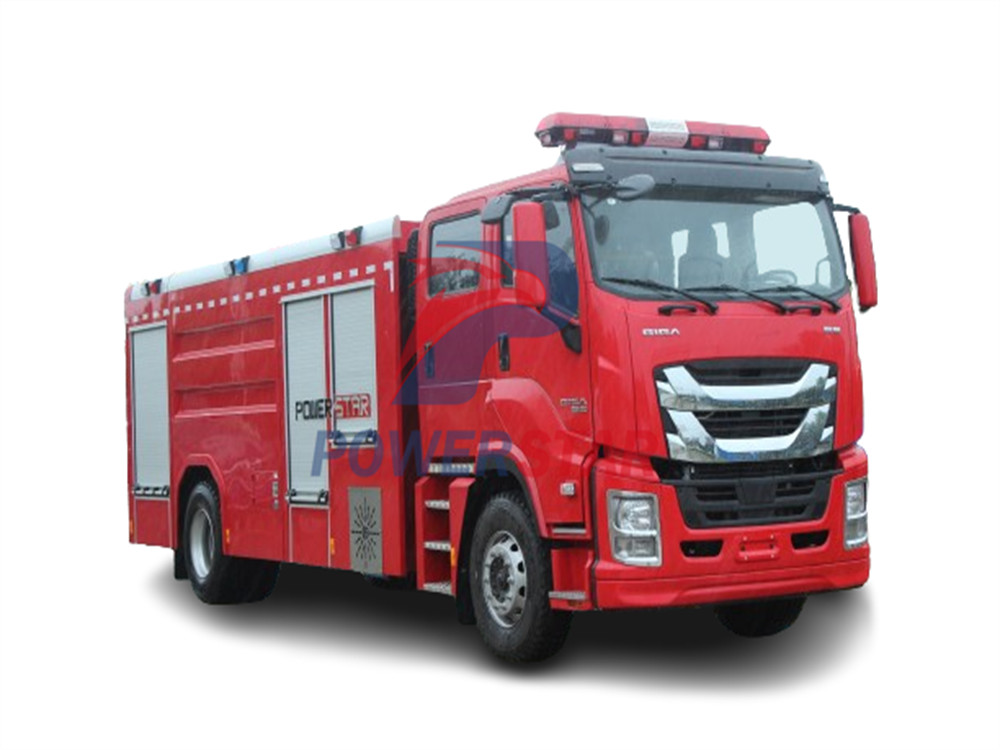
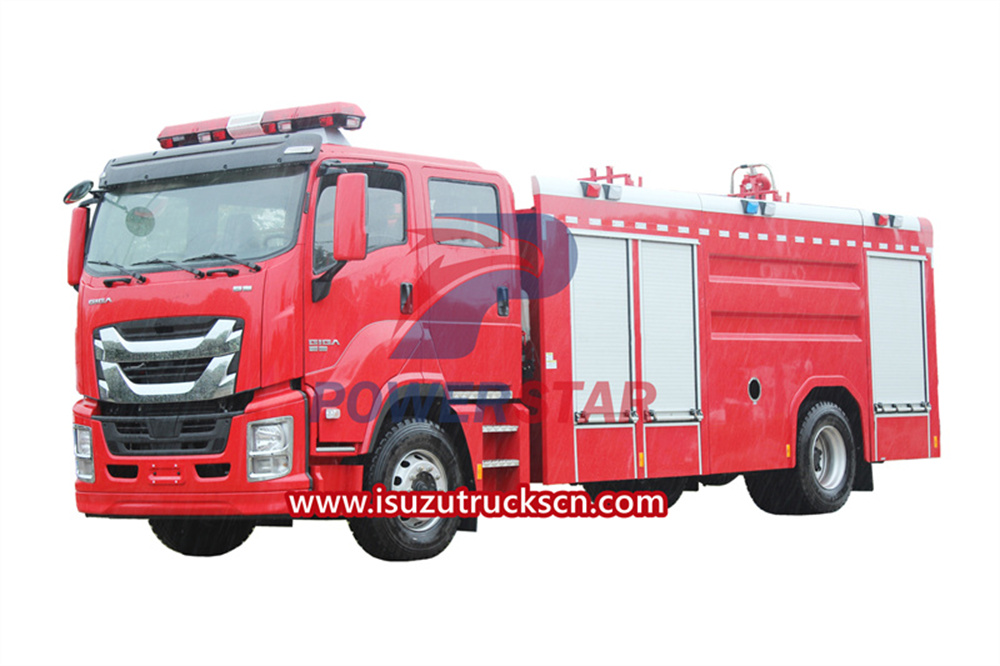
➹ Malfunction problem: The fire pump consumes too much power
________________________________________
1) Wrong direction of rotation
Elimination measures: Check the direction of rotation.
2) Impeller damaged
Elimination measures: Check the impeller and replace it as required.
3) Rotating parts are seized
Elimination measures: Check whether the clearance of internal worn parts is normal.
4) Shaft bending
Elimination measures: straighten the shaft or replace as required.
5) Speed is too high
Elimination measures: Check the winding voltage of the motor or the steam pressure delivered to the turbine.
6) The water head is lower than the rated value. Pumping too much liquid
Elimination measures: Consult the manufacturer. Install the throttle valve and cut the impeller.
7) The liquid is heavier than expected
Elimination measures: Check specific gravity and viscosity.
8) The stuffing box is not stuffed correctly (insufficient stuffing, not stuffed or run-in correctly, stuffing too tight)
Elimination measures: Check the stuffing and refill the stuffing box.
9) Incorrect bearing lubrication or bearing wear
Elimination measures: Check and replace as required.
10) Incorrect running clearance between wear rings
Elimination measures: Check whether the gap is correct. Replace the water pump casing and/or impeller wear rings as required.
11) The stress on the pipes on the pump casing is too great
Elimination measures: Eliminate the stress and consult the manufacturer's representative. After stress relief, check alignment.
➹ Malfunction problem: What should I do if the fire pump is hot?
________________________________________
Cause Analysis:
Bearing damage;
The clearance of the rolling bearing or bracket cover is too small;
The pump shaft is bent or the two shafts are not concentric;
The tape is too tight;
Lack of oil or poor oil quality;
The balance hole on the impeller is clogged, causing the impeller to lose balance and increase the thrust to one side.
Method of exclusion:
Replace bearings;
Remove the back cover and install a gasket between the bracket and the bearing seat;
Investigate the pump shaft or adjust the concentricity of the two shafts;
Properly adjust the tightness of the tape;
Add clean butter, which accounts for about 60% of the gap in the bearing;
Clear the blockage in the balance hole.
➹ Malfunction problem: Fire pump motor overheats
________________________________________
1. Is the packing gland pressed too tightly or the mechanical seal spring adjusted too tightly? Readjust the spring compression amount of the gland or mechanical seal.
2. The use range (flow rate, head) exceeds the design requirements of the fire pump? Select the appropriate motor according to the series type spectrum.
3. The assembly quality of the fire pump is poor. Is there any friction or the motor and the fire pump shaft are not concentric? Check the assembly quality and eliminate assembly faults.
4. If the specific gravity of the medium exceeds the motor configured for the fire pump? Configure a suitable motor for the fire pump.
➹ Malfunction problem: What should I do if the power motor of the fire pump overheats?
________________________________________
1. Power supply reasons:
The voltage is too high or too low. Under a specific load, if the voltage variation range should be outside +10% to -5% of the rated value, it will cause the motor to overheat;
The three-phase voltage of the power supply is asymmetrical, and the imbalance between the three-phase voltages of the power supply exceeds 5%, which will cause the winding to overheat;
Phase loss operation, experience shows that more than 85% of agricultural motors are burned due to phase loss operation, and a phase loss protection device should be installed on the motor.
2. Water pump reasons:
1) If the power is not matched, a small horse pulls a large cart, the motor will be overloaded for a long time, causing the motor temperature to be too high;
2) Motors that are started too frequently and are rated for short-time or intermittent working work continuously. The number of starts should be limited, thermal protection should be selected correctly, and used according to the rated rating calibrated on the motor.
3. Causes of the motor itself:
The connection method is wrong, and the △ shape is mistakenly connected into a Y shape, causing the temperature of the motor to rise rapidly;
The stator winding has phase-to-phase short circuit, inter-turn short circuit or partial grounding. In mild cases, the motor will overheat locally, and in severe cases, the insulation will burn out;
The squirrel cage rotor is broken or defective. When the motor runs for 1 to 2 hours, the iron core temperature rises rapidly;
If the ventilation system fails, check whether the fan is damaged, whether the rotation direction is correct, and whether the ventilation holes are blocked;
Bearing wear and eccentric sweep of the rotor cause the stator and rotor cores to rub against each other, causing a metallic impact sound. The temperature of the core rises rapidly. In severe cases, the motor smokes or even the coil is burned.
4. Reasons related to working environment:
The motor windings are affected by moisture or dust, oil, etc. are attached to the windings, resulting in reduced insulation. The insulation resistance of the motor should be measured and cleaned and dried;
The ambient temperature is too high. When the ambient temperature exceeds 35°C, the inlet air temperature will be high, which will cause the temperature of the motor to be too high, so efforts should be made to improve the working environment. Such as setting up a shed to provide shade, etc.
Note: If a malfunction occurs due to electrical reasons, you should ask an electrician with a professional qualification certificate to repair it. People with little knowledge should not make blind repairs to prevent personal injury accidents.
➹Malfunction problem: Fire pump bearing overheating
________________________________________
1. Are the fire pump and motor shafts not concentric? Adjust and align the fire pump and motor shafts.
2. There is no or not enough lubricating oil (grease). Add lubricating oil (grease) to the required standard.
3. Bearing damaged? Replace with new fire pump bearing.
➹Malfunction problem: The lift of the fire pump is not enough
________________________________________
1) Insufficient rotational speed: Check the current and restore the rotational speed.
2) The gap between the semi-open impeller and the fire pump cover is too large? Reduce the gap.
3) The performance of the fire pump cannot meet the design requirements? Replace with a fire pump that meets the design requirements.
4) The pipeline is too long or has a right-angle bend; shorten the pipeline or change the curvature of the pipeline;
5) The suction lift is high; lower the installation position of the water pump.
6) The bottom valve, pipeline and impeller are partially blocked or the impeller is defective; seal the leakage of the water pump and tighten the packing; clear the blockage and replace the impeller;
7) The water outlet pipe leaks seriously. Replace the leak reduction ring and plug the leak.
➹Malfunction problem: The flow rate of the fire pump is not enough
________________________________________
1) The power speed does not match or the belt slips, causing the speed to be low; restore the rated speed, clean the belt grease, and adjust the belt tightness;
2) The sealing ring is severely worn or corroded? Replace the sealing ring with a new one.
3) The installation angle of the axial flow pump blades is too small; the gap between the semi-open impeller and the fire pump cover is too large? - Adjust the blade angle and reduce the gap.
4) Is the suction pipe too thin or blocked by debris? Change the appropriate pipe and remove the debris.
5) The impeller is severely worn or corroded? Replace the impeller with a new one.
6) The immersion depth of the suction pipe is not enough. Is air being sucked into the fire pump? Increase the immersion depth of the suction pipe. Reinstall the static ring for the fire pump.
➹Malfunction problem: Pump shaft broken
____________________________________
Cause Analysis:
Poor bearing lubrication will cause the bearing to overheat and cause serious wear;
The pump shaft and motor shaft are not concentric;
Overload operation, etc. may cause the pump shaft to break.
Responses:
Regularly check and clean the bearing body in time to ensure there is enough lubricating oil to prevent dry grinding and heat generation;
Regularly calibrate the pump shaft and motor shaft to ensure that the two axes are always on the same center line.
In order to prevent the centrifugal pump bearing rotor from losing stability and breaking, especially high-pressure centrifugal pumps, the unstable speed of the rotor should be controlled to be higher than the maximum working speed of the rotor in the design, and the safety margin should be appropriately considered.
The above situations are common causes of water pump failure, but they are not all causes. When handling failures in practice, due to actual analysis, the principle of first outside first and then inside should be , and never operate blindly.
It is worth noting that when starting the pump, the valve on the outlet pipeline should be closed first to achieve "zero flow" start. Otherwise, the starting current of the motor will be too large and burn out.
